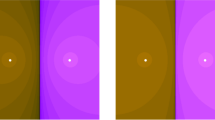Abstract
In this study, first we derive a novel iteration scheme for the sign of a matrix with no pure imaginary eigenvalues. The fourth-order convergence speed of this scheme is given in detail. Secondly, we extend the obtained results so as to calculate the solution of the Yang–Baxter-like equation for the matrix A with no pure imaginary eigenvalues. Some numerical tests are also furnished to manifest the applicability of our method.


Similar content being viewed by others
References
Abell ML, Braselton JP (2017) Mathematica by example, 5th edn. Academic Press, Amsterdam
Baxter RJ (1972) Partition function of the eight-vertex lattice model. Ann Phys 70:193–228
Byers R, He C, Mehrmann V (1997) The matrix sign function method and the computation of invariant subspaces. SIAM J Matrix Anal Appl 18:615–632
Cordero A, Soleymani F, Torregrosa J.R, Zaka Ullah M (2016) Approximating the matrix sign function by means of Chebyshev–Halley type method. In: Proceedings of the 16th international conference on computational and mathematical methods in science and engineering, pp 396–405
Ding J, Rhee N (2013) Spectral solutions of the Yang–Baxter matrix equation. J Math Anal Appl 402:567–573
Ding J, Rhee NH (2012) A nontrivial solution to a stochastic matrix equation. East Asian J Appl Math 2:277–284
Ding J, Rhee NH (2015) Computing solutions of the Yang–Baxter-like matrix equation for diagonalisable matrices. East Asian J Appl Math 5:75–84
Ding J, Zhang C, Rhee NH (2015) Commuting solutions of the Yang–Baxter matrix equation. Appl Math Lett 44:1–4
Ding J, Tian H (2016) Solving the Yang–Baxter-like matrix equation for a class of elementary matrices. Comput Math Appl 72:1541–1548
Dong Q, Ding J (2016) Complete commuting solutions of the Yang–Baxter-like matrix equation for diagonalizable matrices. Comput Math Appl 72:194–201
Higham NJ (2008) Functions of matrices: theory and computation. society for industrial and applied mathematics, Philadelphia
Howland JL (1983) The sign matrix and the separation of matrix eigenvalues. Linear Alg Appl 49:221–232
Kenney CS, Laub AJ (1991) Rational iterative methods for the matrix sign function. SIAM J Matrix Anal Appl 12:273–291
Le Gall F (2014) Powers of tensors and fast matrix multiplication, Proceedings of the 39th International Symposium on Symbolic and Algebraic Computation (ISSAC 2014). arXiv:1401.7714
Leyva-Ramos J (2013) A note on mode decoupling of linear time-invariant systems using the generalized sign matrix. Appl Math Comput 219:10817–10821
Roberts JD (1980) Linear model reduction and solution of the algebraic Riccati equation by use of the sign function. Int J Control 32:677–687
Saray BN (2019) An efficient algorithm for solving Volterra integro-differential equations based on Alpert’s multi-wavelets Galerkin method. J Comput Appl Math 348:453–465
Seyedi SH, Saray BN, Ramazani A (2018) On the multiscale simulation of squeezing nanofluid flow by a highprecision scheme. Powder Technol 340:264–273
Shen D, Wei M, Jia Z-G (2018) On commuting solutions of the Yang–Baxter-like matrix equation. J Math Anal Appl 462:665–696
Soleymani F, Tohidi E, Shateyi S, Haghani FK (2014) Some matrix iterations for computing matrix sign function. J Appl Math 2014:9
Soleymani F, Haghani FK, Shateyi S (2016) Several numerical methods for computing unitary polar factor of a matrix. Adv Diff Equ 2016:1–11
Soleymani F, Stanimirović PS, Shateyi S, Khaksar Haghani F (2014) Approximating the matrix sign function using a novel iterative method. Abs Appl Anal 2014:9
Tian H (2016) All solutions of the Yang–Baxter-like matrix equation for rank-one matrices. Appl Math Lett 51:55–59
Yang CN (1967) Some exact results for the many-body problem in one dimension with repulsive delta-function interaction. Phys Rev Lett 19:1312–1315
Yang CN, Ge ML (1989) Braid group, knot theory, and statistical mechanics. World Scientific, Singapore
Author information
Authors and Affiliations
Corresponding author
Additional information
Communicated by Jinyun Yuan.
Publisher's Note
Springer Nature remains neutral with regard to jurisdictional claims in published maps and institutional affiliations.
Rights and permissions
About this article
Cite this article
Soleymani, F., Kumar, A. A fourth-order method for computing the sign function of a matrix with application in the Yang–Baxter-like matrix equation. Comp. Appl. Math. 38, 64 (2019). https://doi.org/10.1007/s40314-019-0816-6
Received:
Revised:
Accepted:
Published:
DOI: https://doi.org/10.1007/s40314-019-0816-6




